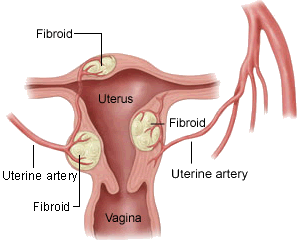Navigation Menu
|
|
 |
|
|
Can fibroids turn into cancer?
|
Uterine Fibroids Uterine fibroids
are solid muscle tissue growths in the uterus. Affect more than 30% of women.
They are also called fibroid tumors, myomas (short for leiomyoma).
Fibroids occur so frequently (in up to half of all women over forty) that they
could be considered a normal irregularity. The occasional fibroid can become
enormously large, but the majority (80%) remain as small as a walnut. Fibroids are
the number one reason American women have hysterectomies.
What causes fibroids?No one knows for sure what causes fibroids. Researchers have some theories, but most likely, fibroids are the result of many factors interacting with each other. These factors could be hormonal (affected by estrogen levels), genetic (running in families), environmental, or a combination of all three. Because no one knows for sure what causes fibroids, we also don't know what causes them to grow or shrink. For the most part, fibroids stop growing or shrink after menopause. But, this is not true for all women with fibroids. Can fibroids turn into cancer?Fibroids are almost always benign, or not cancerous, and they rarely turn into cancer (less than 0.1 percent of cases). Having fibroids does not increase a woman's chances of getting cancer of the uterus. Who gets fibroids?Most of the time, fibroids grow in women of childbearing age. While no one knows for sure what will increase a woman's chances of getting fibroids, researchers have found that African American women are 2 to 3 times more likely to get them than women of other racial groups are. African American women also tend to get fibroids at a younger age than do other women with fibroids. Women who are overweight or obese also are at a slightly higher risk for fibroids than women who are not overweight. Women who have given birth appear to be at a lower risk for fibroids. Research is now being done to figure out who is at risk for fibroids Fibroids may require
treatment in the following circumstances:
Natural
measure Small fibroids often
disappear spontaneously. Larger fibroids are more difficult to resolve, but not
impossible to control with natural measures. One woman’s fibroids (and
menstrual cramps) disappeared within three months of beginning a vigorous
exercise program. Exercise helps insure regular ovulation, and irregular
ovulation seems to worsen fibroids. Consuming three or more
servings of whole grains or beans daily not only reduces the size of fibroids
but offers protection from breast and endometrial cancers as well. Red clover flowers (Trifolium
pratense), are one of my favorite infusions, but use during the menopausal years
may increase difficulty with fibroids. Strengthening the liver with
herbs such as dandelion, milk thistle seed, or yellow dock root helps it
metabolize estrogen out of the body, thus reducing fibroids. Ask someone to burn moxa
over the area of the fibroid while you envision the heat releasing the treasures
in your uterus. What is locked up in this fibroid? What can you give birth to? Acupuncture
treatments and Traditional Chinese Medicine can shrink fibroids. Reduce fibroids by reducing
your exposure to estrogen: avoid birth control pills, ERT/HRT, estrogen-mimicing
residues from herbicides and pesticides used on food crops (eat
organically-raised products). Tampons Lupron (leuprolide acetate),
a drug which induces “artificial menopause” by shutting down the body's
production of estradiol causes a significant decrease in fibroid size within
8-12 weeks. Fibroids do regrow Major advances have been
made in surgical treatments for women with fibroids. There are many options now
besides hysterectomy (removal of the uterus), including hysteroscopic resection,
uterine embolization, Hysterectomy can be a
life-saving procedure, but by the age of sixty, more than one-third of American
women will have given up their wombs to the surgeons. The presence of
non-symptomatic fibroids is never With very few exceptions, no
woman is healthier without her ovaries. So, even if you elect a hysterectomy,
keep your ovaries. |
